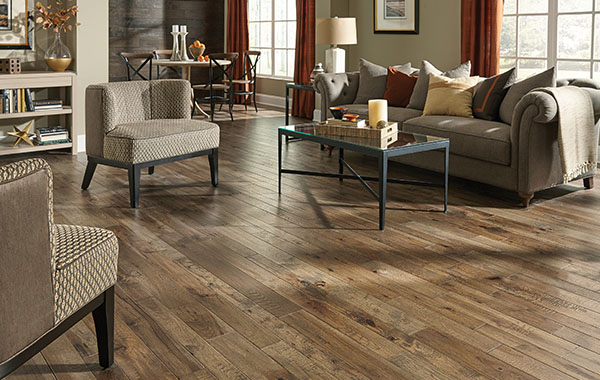Engineered vs. Solid Hardwood Flooring
If you are having trouble deciding between an engineered or solid wood product, you are not alone. It is one of the most commonly misunderstood flooring facts. This simple and concise explanation will point you in the right direction. Here are a couple of quick points to keep in mind as you learn more about the differences between these flooring types.
-
Solid hardwood is completely solid throughout, while engineered hardwood is made up of several layers.
-
When trying to find the best hardwood option, there are a variety of factors to consider such as climate, subflooring material, etc.
Construction: Defining the Difference Between Engineered and Solid Hardwood
Both engineered and solid wood floors are, in fact, hardwood floors. Widely misinterpreted, the term "engineered wood" in the flooring industry does not correlate to a laminate floor. Laminate is a totally different product. The simple difference between engineered and solid wood flooring lies underneath the surface you see on the top of the plank.
Solid hardwood is literally constructed of a solid plank of lumber that is milled to a uniform thickness and width.
Engineered hardwood is simply multiple layers of wood veneers with the stained specie of choice on the top with the same protective urethane applied as with the solid counterpart. The cross-layer construction of the veneers is designed to reduce expansion with dimensional stability.
Both solid and engineered planks are manufactured with the same tongue
and groove type construction along the edges of the plank to enable the interlocking during installation.
Determining the Best Option
Your qualified hardwood installer and your retail salesperson will be able to assist you in deciding between a solid hardwood or an engineered hardwood. Solid hardwood may be installed on the ground level and upper level(s) of your home. Without proper use of HVAC or humidity control, solid planks have a tendency to cup or crown in a high humidity environment, causing movement which can result in buckling.

An engineered hardwood may be installed on all levels of your home, including the basement. Generally, it is the preferred construction for high humidity climates or areas adjacent to waterfronts. Engineered construction is a must if you select plank widths wider than 3 or 4 inches in this type of geography.
Both engineered and solid hardwood are natural products and some expansion and contraction is expected with seasonal changes. All hardwood must be acclimated to the temperature of your home before installation, at least 24-48 hours, as recommended by the NWFA and stated in manufacturer installation instructions.
When you determine whether engineered or solid hardwood flooring is right for the application and specific space, you must then choose the right flooring dealer to make the purchase.
Once you do so, obtain a clear final quote for the flooring project. This means it should include everything from underlayment, moldings, trim, adhesives, subfloor prep, installation and the flooring material itself. Also, be sure to inquire how long the quote is valid, as hardwood flooring pricing fluctuates based on the availability of raw materials.
It is important to consult with your professional hardwood flooring retailer for guidance on making a hardwood selection that is best suited for the condition of your subfloor and your geographical climate. Twenty & Oak brands offer many hardwood options in both constructions, in classic and on-trend visuals.
For instance, Twenty & Oak offers numerous types of hardwood species, each with their own distinctly unique look. We offer hickory with its strong character and color variance as well as red and white oak, species that are valued for sustainability and durability.
Signs Your Wood Floors Need An Upgrade
There are many ways to tell if your wood floors need to be upgraded. While wood flooring can be sanded and refinished back to its original glory, it’s also important to know when hardwood floors are beyond repair. Exposed nail heads and shifting planks are signs that your hardwood needs to be upgraded or repaired.
Commonly Asked Questions About Hardwood Floors
When considering a hardwood floor installation, homeowners and customers usually have a lot of questions. But the two most commonly asked questions about hardwoods revolve around how to maintain them and keep them looking beautiful. Essentially, how does a customer protect their wood flooring surface and how do they go about restaining and refinishing them? Check out this in-depth post if you have more questions about hardwood flooring.
Additional Images Photo Credits: iStock